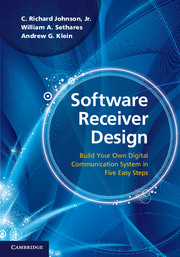Book contents
- Frontmatter
- To the Instructor …
- Contents
- Dedication
- Step 1 The Big Picture
- Step 2 The Basic Components
- Step 3 The Idealized System
- Step 4 The Adaptive Components
- 10 Carrier Recovery
- 11 Pulse Shaping and Receive Filtering
- 12 Timing Recovery
- 13 Linear Equalization
- 14 Coding
- Step 5 Putting It All Together
- Appendices
- Index
- References
13 - Linear Equalization
from Step 4 - The Adaptive Components
Published online by Cambridge University Press: 05 June 2012
- Frontmatter
- To the Instructor …
- Contents
- Dedication
- Step 1 The Big Picture
- Step 2 The Basic Components
- Step 3 The Idealized System
- Step 4 The Adaptive Components
- 10 Carrier Recovery
- 11 Pulse Shaping and Receive Filtering
- 12 Timing Recovery
- 13 Linear Equalization
- 14 Coding
- Step 5 Putting It All Together
- Appendices
- Index
- References
Summary
When all is well in the receiver, there is no interaction between successive symbols; each symbol arrives and is decoded independently of all others. But when symbols interact, when the waveform of one symbol corrupts the value of a nearby symbol, then the received signal becomes distorted. It is difficult to decipher the message from such a received signal. This impairment is called “intersymbol interference” and was discussed in Chapter 11 in terms of non-Nyquist pulse shapes overlapping in time. This chapter considers another source of interference between symbols that is caused by multipath reflections (or frequency-selective dispersion) in the channel.
When there is no intersymbol interference (from a multipath channel, from imperfect pulse shaping, or from imperfect timing), the impulse response of the system from the source to the recovered message has a single nonzero term. The amplitude of this single “spike” depends on the transmission losses, and the delay is determined by the transmission time. When there is intersymbol interference caused by a multipath channel, this single spike is “scattered,” duplicated once for each path in the channel. The number of nonzero terms in the impulse response increases. The channel can be modeled as a finite-impulse-response, linear filter C, and the delay spread is the total time interval during which reflections with significant energy arrive. The idea of the equalizer is to build (another) filter in the receiver that counteracts the effect of the channel. In essence, the equalizer must “unscatter” the impulse response.
- Type
- Chapter
- Information
- Software Receiver DesignBuild your Own Digital Communication System in Five Easy Steps, pp. 270 - 302Publisher: Cambridge University PressPrint publication year: 2011



